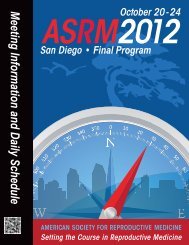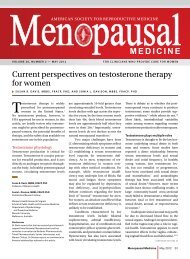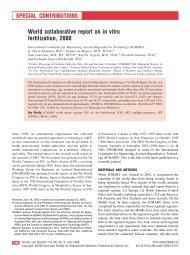scientific program • symposia - American Society for Reproductive ...
scientific program • symposia - American Society for Reproductive ...
scientific program • symposia - American Society for Reproductive ...
You also want an ePaper? Increase the reach of your titles
YUMPU automatically turns print PDFs into web optimized ePapers that Google loves.
ART, UROLOGY AND PATIENT EDUCATION<br />
Moderators: Tien Cheng “Arthur” Chang, E.L.D., Ph.D., and<br />
Marius Meintjes, D.V.M, Ph.D.<br />
V-1 11:18 AM<br />
NON-INVASIVE ASSESSMENT OF EMBRYO VIABILITY USING<br />
NOVEL AUTOMATED IMAGING TECHNOLOGY.<br />
B. Behr1, S. L. Chavez1,2,4, K. E. Loewke1,4, R. A. Reijo<br />
Pera1,2. 1Department of Obstetrics and Gynecology,<br />
Stan<strong>for</strong>d University School of Medicine, Stan<strong>for</strong>d, CA;<br />
2Institute <strong>for</strong> Stem Cell Biology and Regenerative Medicine,<br />
Stan<strong>for</strong>d University School of Medicine, Stan<strong>for</strong>d, CA;<br />
3Department of Mechanical Engineering, Stan<strong>for</strong>d<br />
University, Stan<strong>for</strong>d, CA; 4Auxogyn, Inc., Menlo Park, CA.<br />
OBJECTIVE: Recently, we demonstrated that the success or<br />
failure of human embryos in reaching the blastocyst stage<br />
can be predicted by the 4-cell stage of development<br />
with >93% sensitivity and specificity using three cell cycle<br />
imaging parameters observed prior to embryonic genome<br />
activation. Analysis of gene expression profiles indicated<br />
that embryos predicted to develop to the blastocyst stage<br />
differ in gene expression patterns from those that arrest<br />
prior to blastocyst <strong>for</strong>mation, suggesting that these imaging<br />
parameters can be used as a non-invasive indicator of<br />
the underlying molecular <strong>program</strong>s. Here, we describe the<br />
development of novel time-lapse imaging technology that<br />
can be used in a conventional incubator with automatic<br />
image data processing <strong>for</strong> the prediction of embryo viability.<br />
DESIGN: In order <strong>for</strong> the time-lapse microscope to fit in a<br />
standard incubator, only the critical components of the<br />
microscope are used and designed <strong>for</strong> a short optical path.<br />
To ensure embryo light safety, the microscope is comprised<br />
of a low power LED, high sensitivity camera and darkfield<br />
illumination, the latter of which also provides high contrast<br />
between the cell membranes and cytoplasm <strong>for</strong> easy cell<br />
tracking. Extraction of the cell cycle parameters is achieved<br />
by automated software and a cell tracking algorithm,<br />
whereby each image is compared to all predicted<br />
simulations and assigned a likelihood based on similarity to<br />
achieve the best fit model.<br />
MATERIALS AND METHODS: With the development of<br />
this novel automated imaging technology and the<br />
recent identification of the three non-invasive cell cycle<br />
parameters that accurately predict blastocyst <strong>for</strong>mation by<br />
the 4-cell stage, there is great potential to translate these<br />
<strong>scientific</strong> findings into IVF laboratories and improve embryo<br />
selection in combination with other criteria currently used in<br />
clinical practice.<br />
Disclosures: SC and KL are now employees of Auxogyn,<br />
Inc., which licensed intellectual property resulting from this<br />
research. BB and RRP own stock in Auxogyn.<br />
__________________________________________________________<br />
V-2 11:25 AM<br />
A NOVEL MECHANISM IN THE DEVELOPMENT OF HUMAN<br />
EMBRYOS WITH A SINGLE PRONUCLEUS (PN) AND TWO<br />
UNEVEN PN IDENTIFIED BY TIME-LAPSE CINEMATOGRAPHY.<br />
Y. Mio, K. Yumoto, K. Iwata, A. Imajyo, Y. Iba. <strong>Reproductive</strong><br />
Centre, Mio Fertility Clinic, Yonago, Tottori Prefecture, Japan.<br />
OBJECTIVE: Although human embryos with a single<br />
pronucleus (1PN) or uneven two pronuclei (≥10 μl of<br />
VIDEO PROGRAM<br />
Tuesday, October 18, 2011 11:15 am – 1:00 pm<br />
ASRM Video Session I<br />
Chapin Theatre<br />
95<br />
difference in diameter) are clinically observed on 16 to 18<br />
hours after assisted reproductive technologies (IVF/ICSI),<br />
the detailed mechanism in the development of these<br />
embryos are still unknown. Recently, we determined a novel<br />
mechanism occurring embryos with 1PN or uneven 2PN after<br />
ICSI using time-lapse cinematography (TLC).<br />
DESIGN: The TLC of donated ICSI embryos from 109 couples<br />
was per<strong>for</strong>med between April 2002 and December 2009.<br />
Each ICSI oocyte was placed in 5μl of pre-equilibrated<br />
fertilization medium within a TLC chamber on the stage of<br />
an inverted microscope. Images were captured every 2<br />
minutes (50 ms exposure time) <strong>for</strong> approximately 40 hours. Of<br />
109 mature oocytes that underwent ICSI, 3 of both embryos<br />
with 1PN or uneven 2PN were obtained from the TLC study.<br />
MATERIALS AND METHODS: In 3 embryos with 1PN, an<br />
unknown material was extruded next to 2nd polar body<br />
(PB) 15 minutes after the extrusion of 2nd PB and continued<br />
to exist in the perivitelline space until completion of the 1st<br />
cleavage, whereas the male PN <strong>for</strong>med in the center of the<br />
cytoplasm at 4.2 hours after ICSI. Although 3 embryos with<br />
uneven 2PN also extruded an unknown material next to 2nd<br />
PB, these embryos <strong>for</strong>med small PN-like substance (likely 3rd<br />
PB) within the unknown material in the perivitelline space.<br />
Afterward, the small PN-like substance incorporated into<br />
ooplasm followed by migration to the male pronucleus and<br />
abutment of both pronuclei.<br />
This study firstly demonstrated the novel phenomena during<br />
the miotic division in human embryos. Further TLC study will<br />
give us more in<strong>for</strong>mation about this enigmatic phenomena.<br />
__________________________________________________________<br />
V-3 11:32 AM<br />
TIME-LAPSE IMAGING OF TRIPRONUCLEAR EMBRYOS:<br />
MECHANISMS OF FORMATION AND ABNORMAL<br />
DEVELOPMENT.<br />
R. S. Weinerman1, M. E. Fino1, Y. Kramer1, K. C. Gunsalus2,<br />
C. McCaffrey1, N. Noyes1. 1NYU Fertility Center, New York<br />
University School of Medicine, New York, NY; 2Center <strong>for</strong><br />
Genomics and Systems Biology, New York University, New<br />
York, NY..<br />
OBJECTIVE: This video presents examples of abnormal<br />
embryo development in tri-pronuclear embryos originating<br />
from IVF±ICSI as viewed using time-lapse microscopy (TLM).<br />
The mechanisms of tri-pronuclear embryo <strong>for</strong>mation are<br />
explained and resulting developmental phenotypes are<br />
highlighted. Specific topics reviewed include mitotic spindle<br />
<strong>for</strong>mation, early embryo fragmentation, and early embryo<br />
arrest.<br />
DESIGN: Our research laboratory routinely employs TLM<br />
as a means to study early embryogenesis. Our standard<br />
clinical IVF practice is to assess all oocytes <strong>for</strong> evidence<br />
of fertilization and to document pronuclear status 18 h<br />
post-insemination by either conventional insemination or<br />
ICSI. Those zygotes containing ≥3 pronuclei are deemed<br />
unsuitable <strong>for</strong> uterine replacement and are sometimes<br />
designated <strong>for</strong> continued culture and monitoring using TLM,<br />
if the patient had signed IRB-approved in<strong>for</strong>med consent<br />
<strong>for</strong> research on this material. These abnormal zygotes are<br />
placed in a stage-top incubator and viewed using highdefinition<br />
microscopy. Images are captured every 240-420








